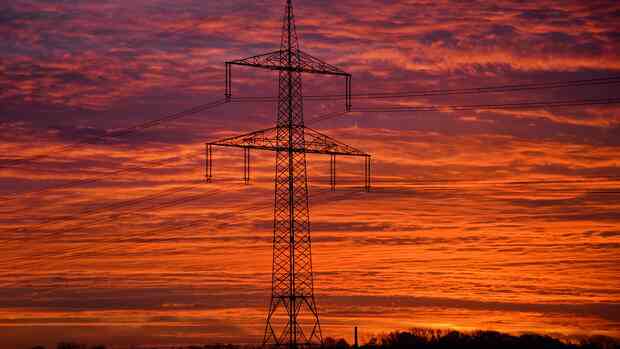The expansion of the power grid is lagging behind the targets. This puts a strain on the energy transition.
(Photo: dpa)
Berlin The progress of the energy transition in Germany falls far short of the targets. This is proven by the current energy transition monitoring by the consulting company Prognos for the Association of Bavarian Business (vbw). “The results of the monitoring are anything but satisfactory,” said vbw CEO Bertram Brossardt on Friday.
In many categories, the results are worse than in the monitoring from last year. “This must be a wake-up call. If the energy crisis is the mother of all crises, the energy transition is the mother of all crisis solutions,” said Brossardt. He called for the expansion of renewable energies and the expansion of the power grids to be significantly pushed.
From Brossardt’s point of view, the development of energy prices is particularly burdensome. “In terms of industrial electricity, we occupy the penultimate place within the EU, only Cyprus is more expensive,” he said. Brossardt called for political solutions: “A uniform industrial electricity price, preferably at European level,” is urgently needed.
The topic is now high on the priority list of Federal Minister of Economics Robert Habeck (Greens): “We need a European industrial electricity price,” Habeck said on Monday at the Handelsblatt energy summit. The energy price crisis cannot be solved without a transnational solution. “It has to happen that way, and I think it’s realistic,” Habeck emphasized.
Top jobs of the day
Find the best jobs now and
be notified by email.
The Prognos energy transition monitoring for vbw has been an indicator of the progress of the energy transition for years. The monitoring presented on Friday is the eleventh edition.
Evaluation traffic light on “red” in eight out of ten cases
The monitoring evaluates ten points – from the power failure time to the development of greenhouse gas emissions – from the areas of security of supply, affordability, efficiency and renewables as well as greenhouse gas emissions. In eight out of ten cases, the evaluation traffic light is on “red” this time.
Brossardt believes that the energy supply crisis is largely a supply crisis. He therefore calls for the ban on extracting natural gas in Germany using the controversial fracking method to be reviewed. He also advocates allowing the nuclear power plants to continue to run in continuous operation beyond April 15th until 2024.
He attaches great importance to hydrogen in the future energy mix. It plays an important role as a substitute for natural gas in the generation of process heat in industrial plants, for stabilizing power generation and also for new drive systems. In addition, hydrogen is also an industrial policy opportunity. Innovative technologies from Germany relating to hydrogen technology have the potential to be used worldwide for the benefit of the environment.
The federal government set some goals for the expansion of renewable energies. By 2030, their share of electricity consumption should be 80 percent. According to estimates by the Working Group on Energy Balances, the share of renewables in electricity consumption was 46 percent last year. In 2018 it was still 37.7 percent.
>> Read here: Germany must build six wind turbines a day by the end of 2029
If you look at the entry into force of the Renewable Energy Sources Act (EEG) in 2000 as the starting signal, it took 22 years to reach 46 percent. So now the missing 34 percent should be reached within eight years. Many experts consider this to be very ambitious.
Almost 30,000 wind turbines are now turning on meadows, fields and in the North and Baltic Seas.
(Photo: dpa)
The federal government recently failed to meet its goal of further reducing greenhouse gas emissions. According to calculations by the Agora Energiewende think tank, which were published in early January, emissions stagnated last year.
Accordingly, the emission reduction in 2022 compared to the reference year 1990 was almost 39 percent and thus for the second time behind the climate target of 40 percent achieved in 2020. One of the reasons for this is the increased use of coal to generate electricity due to the gas supply crisis.
More: Federal government creates new areas for offshore wind power

